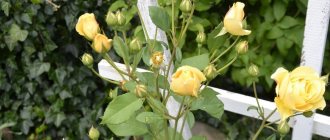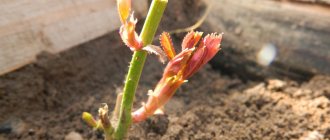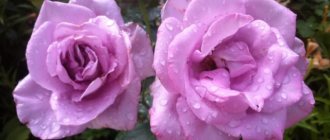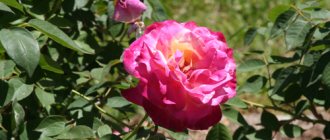Many people associate the Rococo rose with the queen of flowers. A bouquet of roses is suitable for almost any event. Roses look great in the hands of women of any age and are perceived as a symbol of love and fidelity. Roses have more than once become objects for creativity - they were sung in poetry, depicted in paintings and family coats of arms, described in prose, and even learned to embroider. For example, a Rococo rose is embroidered from threads of three shades. The petals are formed from rococo knots, and the core of the flower is obtained from a rococo loop. This rose variety was developed relatively recently. To be more precise, in the Federal Republic of Germany there are two varieties of roses called Rococo. One of them is Rugosa - a not very tall flower, peach in color, which was demonstrated in 1990. The other rose is soft apricot in color, presented by Tantau in 1987. The Rokoko Tantau variety is more popular and widespread among gardeners. The apricot-colored buds, having opened into double flowers, gradually change their color to beige.
Origin
The birthplace of this gorgeous plant is Germany. In 1987, the German breeder Tantau introduced a new scrub - the Rococo rose. When developing a new variety, he managed to preserve and express the splendor of the tones and shapes of old roses. For this reason, the rose is included in the “Nostalgic Dreams” series.
The climbing rose should not be confused with the Rococo bush rose. The second is rugosa, the “parent” of which is the wrinkled rose hip, and it is not tall. The rose in question is considered the best and is used to decorate arches and arbors.
Description of the Rococo rose
The climbing plant can be found in recreation areas. The rose has an aristocratic and rather rich appearance. It has such charm because of its pastel color and abundance of flowering. Through the foliage you can see how flexible but strong shoots tightly wrap around their base. They reach a height of 180 cm and a width of 1 meter.
Rose "Rococo" can be called a "mystery", as its colors vary from milky pink to apricot tones. Moreover, this manifests itself on one inflorescence. If you take a closer look at each individual flower, it becomes clear why the rose looks so lush. Terry petals overlap each other in waves, leaving open space for a wonderful center. All these beautiful features are clearly visible in the photo of the Rococo rose.
Flowering occurs in two waves and the bulk of the flowers are released in the first. And this is natural, because the plant releases the energy and minerals that have accumulated in it. The flowering period lasts from June until autumn. Each inflorescence has 3 large buds. Unfortunately, blooming roses wither after 5 days and become too faded. But new flowers come to the rescue, opening every day.
The leaves of the Rococo rose are sparsely spaced. Their glossy surface and rich green color give the bush a decorative appearance. Rose has a distinct aroma.
When ordering a seedling, you need to pay attention to the fact that its root is packed in a wet peat mixture and wrapped in film. Thanks to this, he will be delivered alive and will settle down perfectly in his new place. If, when purchasing a rose, the bush is filled with wax, then there is no need to remove it.
Growing conditions
Let's find out where it is better to plant a Rococo rose and what conditions the plant needs to be provided.
Description of the place
It is recommended to plant this variety in a sunny place that is well lit throughout the day. It is in such conditions that the rose will be able to demonstrate all its amazing decorativeness. You can’t plant it in the shade: the buds will be small and the flowering period will be short.
It is not worth growing the flower even in light partial shade, not to mention significantly shaded areas. The more open and sunny the place, the more decorative Rococo will delight you.
It is strictly not recommended to plant this variety in lowlands with stagnant soil: such conditions lead to root rot and plant diseases.
It is forbidden to plant the plant in a flowerbed where other roses have previously grown. Plants may have common infections and pests that are likely to persist in the soil.
Temperature
Rose Rococo should be grown in a warm place: this variety is not suitable for the northern regions, except for greenhouses and hothouses. For the winter, the bush must be covered.
Humidity
The Rokoko rose feels best when the air humidity is slightly above average. The plant does not tolerate drafts: make sure that the bush is protected from the north by a wall or fence.
Soil composition and structure
Rose prefers loamy soil, moisture-absorbing and with good drainage properties. Sandy loam soil will also work, provided it is sufficiently fertile and drainable. The soil in the garden bed is dug up, loosened, then nutrients are added to it, and only then holes for planting are formed.
Selection of seedlings
In nurseries, seedlings of this rose are usually sold with closed roots. This means that the roots of the plant are “hidden” in a layer of soil protected by paper and polyethylene. Before placing the seedling in the ground, the polyethylene and the tube on top are removed, and the paper is left.
Saplings with an open root system are sold much less often.
In this case, close attention should be paid to the roots: they should have an even light shade, not be damaged or weak. Rot and dark spots on the roots are unacceptable. Inspect the plant itself: at least three shoots should extend from the trunk
This is the key to future good branching of the rose.
Inspect the plant itself: at least three shoots should extend from the trunk. This is the key to future good branching of the rose.
Landing Features
It is recommended to choose spring for planting this rose: May is optimal. It is this period of time that is recommended by the breeding company and manufacturers of planting material. However, if the climate is warm, planting can be done in the fall.
If several bushes are planted, do not forget to leave a distance of at least 1.5-2 meters between them. It is unacceptable to thicken the plantings, as this will lead to frequent fungal diseases in the future.
A seedling with an open root system is placed in a hole and the roots must be straightened along the bottom. If the system is closed, then the plant is rooted directly with the “native” earthen lump. The root collar or graft should be located 3-5 cm below the ground level.
After planting, it is recommended to mulch the root zone along its diameter. The measure will protect the roots from drying out and rid the bed of weeds.
Features of the variety
- Frost resistance.
- Excellent immunity to diseases. The Rococo rose variety is especially resistant to black spot and powdery mildew.
- After rains, the plant does not lose its appearance.
- One of the main features is that roses bloom all season.
- The length of the branches is an important criterion for those who decorate flower beds.
Regarding the choice of location, planting and care, the rose does not have any differences from other climbing varieties.
Reproduction
Rose Osiria: photo variety, description, pest protection, video, reviews
Gardeners usually use the cutting method to propagate Rococo roses: at home this is the most logical and simplest option. In addition, the effectiveness of the method is almost 100%.
You can take cuttings from both still flowering shoots and those that have already stopped blooming. Planting material is usually cut in mid-summer - around July 10. Make sure the cutting includes at least two internodes
It is also important to make the lower cut oblique (45 degrees), and the upper one straight
The lower leaves need to be removed, the upper leaves should be shortened by half. Rooting occurs either in soil with sand or in clean sand. The substrate must be moist.
The top of the cutting should be covered with polyethylene or a cut-off five-liter plastic jar and placed in a well-lit place. While the cutting is taking root, it needs to be watered regularly. After the roots have grown, the young rose is planted in a permanent place.
Selecting a location
Ideally, it is better to plant the Rococo climbing rose in parks or in garden plots where trees grow nearby. It is important to consider at what time of day the shadow will fall on the rose. In the morning, the queen of the garden needs the sun to dry the dew on her, which in turn will protect her from fungal diseases. At midday, rose bushes may benefit from nearby bushes. Under this cover, the delicate plant will not get sunburned. If you plan to plant roses near buildings or other tall objects, then the distance should be 1 meter. Bushes should be planted on the south side. A strip of land of 50 cm will be quite enough for the normal development of the plant.
Diseases and pests
Rose Rococo, despite its sophisticated, delicate appearance, is a quite hardy and stable plant, with good immunity. Even an old bush will not hurt much and often. However, the flower is not completely immune from misfortunes.
Stem cancer
A disease such as stem cancer poses a particular danger to shrubs. The pathology appears as red spots, gradually fading and covering increasingly large areas of the plant. As soon as the disease is detected, the affected shoot must be urgently pruned to stop the spread of infection. You need to cut under the stump, making sure to also include the healthy part of the shoot.
In most cases, stem cancer is caused by untimely removal of winter cover. Under cover, rose shoots thrive, especially when the spring sun is already very hot. Therefore, the main preventive measure against cancer is the timely removal of the winter “blanket”.
Powdery mildew
The disease affects the plant if the weather is both humid and hot at the same time for a long time. In such a “bath”, the fungus spreads and multiplies especially actively. The disease is dangerous for the plant, it can deprive the rose of its decorative properties and slow down its development and growth.
They fight powdery mildew by spraying the bush with Bordeaux mixture. The same measure also serves as prevention. If the plant is already sick, it can only be cured by twice spraying: the interval between them is 2 weeks.
Black spot
A contagious fungal disease, and also very dangerous. The symptom of the disease is small brown-red spots with a yellow rim that appear on the leaves of the bush. If the rose is not treated, the spots will begin to grow and merge, forming extensive lesions.
As a preventive measure, the rose is promptly fed with potassium and phosphorus. In addition, a three-phase treatment of the plant with Bordeaux mixture or iron sulfate is necessary. A week is allowed between treatments.
Pests
Most often, gardeners have to fight aphids on roses and spider mites. If there are still few pests, you can get rid of them using safe traditional methods. Usually, decoctions of horsetail and nettle are used for this. It is better to spray in two doses for greater efficiency. If the pests have spread widely, traditional methods will not help: it is better to take an insecticide like Biotlin.
Note that spider mites can settle on a plant only if the weather remains dry for a long time and with infrequent watering. The pest, like aphids, settles on the underside of leaves - that’s where you need to look for it. You can fight with folk methods, using bitter infusions of tobacco, wormwood, etc. And for quick and guaranteed relief, use the drug Fitoverm.
Soil preparation
Rose Rococo is more suitable for loamy soil. If the soil is too heavy, it is diluted with sand during digging. Clay is added to sandy soil. The application of humus and phosphorus fertilizers is mandatory. To create the necessary balance in the soil, the listed actions must be carried out first. 2 weeks before planting, you need to dig holes and fill them with water.
The presence of groundwater should be taken into account, because the roots of climbing roses go deep into the lower layers of the soil. If the waters lie close, in such cases the plants are placed on a slope so that the root system does not retain water.
Landing
In spring, roses are planted from the second half of April, and in autumn - from the end of September. Before planting, seedlings are soaked in water for 24 hours. Then carry out the following actions:
- Unsuccessful or broken shoots are cut off, and all leaves on the remaining ones are cut off. Bare areas are sprinkled with wood ash.
- The buds located below the grafted site are removed. If you ignore this operation, rose hips will begin to grow from below.
- For disinfection, seedlings are immersed in a solution of copper sulfate.
- Immediately before planting, the roots are dipped in mash prepared in this way: clay and water are thickly diluted to make a total of 10 liters; 1 tablet of “Heteroauxin” and 3 tablets of “Phosphorobacterin” are dissolved in a small amount of water and mixed with the total mass.
- When planting, the grafting site is deepened by 10 cm and the rose is watered generously.
- After the ground has subsided a little, you should hill up the bush to a depth of 20 cm.
Growing a flower
Seedlings of any of the varieties of the Rococo series should be purchased from a specialized nursery, which serves as a reliable guarantee that the future bush will comply with all the varietal characteristics declared by the originator.
Mostly seedlings with a closed root system and three strong shoots are used as planting material.
For your information! For planting in the regions of central Russia, scions are used on three-year-old rose hips. This technique allows roses to survive in harsher climates with frosts down to −30 °C.
The best time for planting is spring, when the soil warms up to 10 °C, usually in early May. If autumn planting is chosen, then the best time for it is the first ten days of September, when there are at least 3 weeks left before stable frosts.
Selecting a location
The planting site is chosen in a lighted area, since the buds become noticeably smaller in the shade. Roses should not be planted in low-lying areas, as this leads to stagnation of moisture at the roots and their rotting.
How to prepare the soil and flower for planting
The best soil for climbing rose Rococo is loam with good moisture holding capacity. Sandy loam soils are enriched with humus. Before planting in the fall, the bed is dug up, loosened, humus is added to it, and planting holes are dug next spring.
Step by step landing procedure
The order of work is as follows:
- Planting holes for the Rococo rose variety are dug at a distance of 1.5-2 m from each other. The required hole depth is 40 cm.
- If the seedling has an open root system, then it is soaked for 12 hours in a solution of a root former (kornevin).
- The root collar is immersed in a hole just below the soil surface.
- Fill the hole with soil, to which add a little wood ash, 40 g of superphosphate, as well as several handfuls of humus.
- The soil around the bush is mulched for 40-50 cm with sawdust or peat.
- Water generously.
Planting rose cuttings
Care
Like all climbing roses, the Rococo rose tolerates drought more easily than its bush “sisters”. However, it will look lively if watered twice a week.
After the first loosening, it would be a good idea to mulch the soil around the trunk with humus. This will save you from unnecessary weeding and walking around the flowerbed. You can use pine needles, sunflower husks and other materials as mulch. But this is the case if flowers are planted close to the rose bush, which will cover the mulching material.
In summer, the rose does not need feeding. This is usually done in the fall, along with pruning.
And finally, the most pleasant thing about caring for such a lovely plant is creating support. This is a reason for fantasy. There are plenty of possible options. Weaving bushes are used to create excellent hedges, or to spread lashes onto metal arches or dry trees. Grates installed along the walls look original; you can diversify their shapes.











